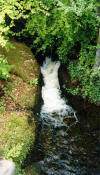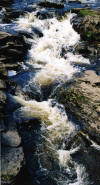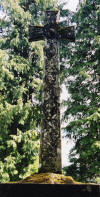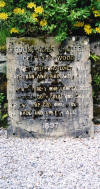|
The Falls of Dochart It was an absolutely beautiful day that took us to the Dochart. The river cascades through the village of Killin in Stirlingshire, at the western end of Loch Tay, and forms numerous falls, pools, and eddies. In places, it is possible to walk out on the rocks, but care should be taken. The stone mill house is now a gift shop. We took many photographs at the Falls of Dochart and moved on toward the west. A quaint little church caught our attention and prompted yet another unplanned stop on our journey.
St. Conan's Kirk
St. Conan's is an interesting, lovely, but sometimes odd mix of various periods and styles of church building. Until the Callander and Oban Railway opened in the 1870s, the area was largely deserted. Once the railway was in place, one Walter Campbell bought Innis Chonain, an island on Loch Awe, and built a house for himself, his sister Helen, and their mother, Roline Agnes Campbell of Blytheswood. Since the nearest church was too far for the elderly Mrs. Campbell to travel to, Walter built St. Conan's on the north shore of the loch. Initial construction was begun in 1881 and completed in five years. After Mrs. Campbell's death in 1897, Walter decided to expand and embellish the building considerably. Then, from Walter's death in 1914 until her own in 1927, Helen continued the work her brother had begun. It was completed by trustees, and the present church opened for worship in 1930. The effigy is of Robert the Bruce, and the lighted window in the side of the casket contains a finger bone taken from the Bruce's grave at Dunfermline Abbey. Leaving St. Conan’s, we drove past Loch Laich at low tide and saw ... Castle Stalker Stalker was built in the mid-15th century by Sir John Stewart of Appin, Lord of Lorn. King James IV of Scotland, a cousin of the Stewarts of Appin, visited here often and used it as a base for hunting and hawking on his journeys to the Highlands. Thus, the castle acquired its name - its Gaelic form, Stalcaire, means Hunter or Falconer. The castle's history has been colorful and volatile, being the object of centuries of conflict between the Stewarts and the Campbells and changing hands several times. It was finally regained by the Stewarts through a purchase in 1908. Over the following decades, the Stewarts rebuilt and restored it to a habitable condition. From Stalker, we went to ... Eilean Donan
___________________________________________________________________________________________________
If you came from the Bed and Breakfasts page,
If you came from a search, click here to begin at the beginning: Home
Copyright 2018 · Loretta Lynn Layman · The House of Lynn |
||||||


















